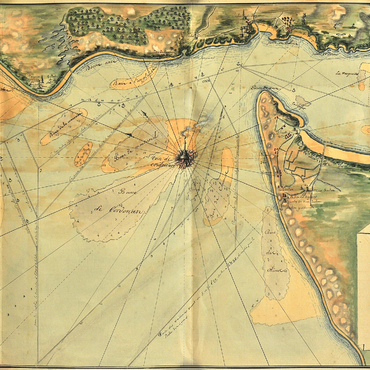
- Home
- Just another lighthouse ?
- The lighthouse keepers
- Lighthouse keepers during the Ancien Régime
Cordouan witnessed a succession of types of lighthouse keepers. Until the sixteenth century, the medieval tower was looked after by two anonymous monks in the tradition of isolation, prayer and service. Each night their mission was to “light the beacon for the safe passage of ships.” Starting with Louis de Foix’s tower, the term guards were used. Under Louis XIV, there were three of them, “pledged to remain, light the beacon each night, and undertake all necessary repairs. Beginning in the eighteenth century, four men were quartered in the tower, each with a precise rank and responsibilities. Commanded by a “head guardian,” they were required to have knowledge of locksmithing and stonework, “not be too young or too old, and of the Catholic faith.” In general, they came from the parishes along the Saintonge bank of the estuary. They were former seamen or artisans, and were recruited after undergoing a morals test. They were managed from Royan, the lighthouse’s logistical center, by the commissaire des classes. The salary was modest (150 livres for guards and 400 for the head keeper). However they were eligible for a pension equivalent to what a sailor would receive. Their work, hypothetically defined by very precise rules, always put “service of the beacon” first: its stocking, upkeep, illumination and the night watch. The lighthouse keepers were jacks of many trades, at once locksmiths, woodworkers and stoneworkers charged with daily repairs and naturally, ongoing cleaning. At the end of the eighteenth century added to these tasks was keeping of the lighthouse’s register and the complex maintenance of the new beacon and the “rotating machine.” Living conditions were very rudimentary. Firstly, there was isolation during the harsh/intemperate seasons when, as the engineer Claude Masse pointed out at the beginning of the eighteenth century, “they might not receive any help from dry land for two or three months.” During this time they lived off supplies and provisions stocked for six months. The connection, which was tentative at best, could only occasionally be carried out by pilots from Royan, and then by the launch assigned to the lighthouse, not to mention a system of smoke signals and flags for communicating with the coast. Visits to dry land were short affairs, "taking turns during the springtime to relax". They followed the traditionally frugal sailors’ diet based on sea biscuits from a barrel, lard, butter, cheese, and supplemented by whatever fish could be caught from the lighthouse’s rocky plateau. There was wine, and water was captured by an ingenious recuperation system and stored in water tanks/cisterns. Finally, the keepers were quartered in tiny rooms in the lighthouse’s base. The isolation, difficulty of the work, intemperate weather, humidity and cold quickly wore down the keepers and made it difficult to recruit men, given the image of the work given by a head guardian in 1783 “who was entirely put off by this dreadful stay in winter.”

